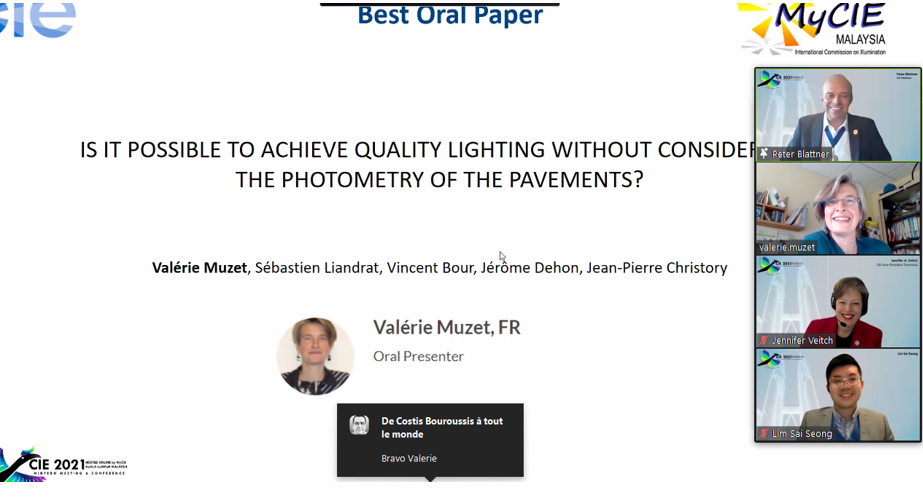

News of the project teams STI research project: Intelligent Transport Systems, towards more safety and integration into sustainable territories
and ENDSUM Non Destructive Evaluation of Structures and Materials
The ICE sessions, these meetings and conferences for international experts, were held exclusively online this year. They are the privileged meeting place for the scientific community conducting research in the fields of lighting and light. Researchers, experts and engineers can present and discuss their work in different application fields, from human vision and colour perception, to road lighting visibility, metrology and instrumentation, to light pollution and the non-visible effects of light.
Cerema has an international presence in the field of public space lighting
This year, four communications at the initiative of initiative of Cerema (lighting team and light - Angers, research team ENDSUM - Strasbourg, STI research team - Clermont-Ferrand) were presented Clermont-Ferrand) were presented in two sessions dedicated to outdoor lighting. This strong representation of Cerema and the selection of the communications offered illustrates once again the important role that the establishment plays in terms of international research and standardization on the issues raised by the Division 4 of the CIE, which works on the design principles for outdoor lighting and signage.
France was very present at the session 01 "Road Surfaces" with 3 presentations from Cerema and one from presentation of the Gustave Eiffel University (see the program and the presenters in the figure below).

In the session 15 "Road Lighting Metrics", Cerema presented work carried out in collaboration with the Technical University of Berlin, in the framework of the SAVAPHOR project: Alternative Solution for On-Site Assessment of Pavement Coatings.
This collaboration was initiated thanks to funding from Cerema's "Tremplin vers l'Europe et International". It will allow Cerema to to have an influence on international decisions related to lighting standards and could lead to future research projects.

Cerema's communications
Is it possible to obtain quality lighting without taking into account the photometry of the coatings?
Muzet V, Liandrat S, Bour V, Dehon J, Christory J.P.
In this study, the photometry of a wide range of conventional and innovative coatings used in urban and interurban areas was characterized when new and after 30 months of natural ageing.
Simulations of lighting installation renovation cases show that the use of the typical CIE tables leads almost systematically to non-compliance with the EN 13201 standard, especially in terms of uniformity of the lighting. Taking into account the photometry of the pavement in the stabilized state allows simultaneously to comply with safety regulations safety regulations and to achieve significant energy savings.
As pavement photometry measurements are rarely performed, an alternative is to build a database of urban pavements, which is one of the objectives of the working group 'Surfacing & Light'.
This paper received the ultimate award in the Oral Paper's category as it was the best!

Influence of the coating on the calculation of the visibility of a target taking into account direct and indirect lighting
Lebouc L, Boucher V, Greffier F, Liandrat S, Nicolaï A, Richard P.
In this article, the performance of a lighting installation with different pavement types are simulated in accordance in accordance with road lighting standards. The The calculation of the visibility level of a target according to the Adrian model is developed.
Then, the light reflections on the road surface surface of the road are added to the calculation of the luminance of the target. For this, the surface considered in front of the target as well as the number of elementary surfaces are fixed and a scaling of the table-r is performed.
We compare the results obtained for each section with and without taking into account the light reflections and conclude that the impact of the nature of the road surface on the luminance of the target is negligible. However, an effect of the road surface on the visibility level of the target is observed.
How to take into account the heterogeneity of the optical properties of coatings in a lighting design?
Clerk F, Muzet V, Boucher V.

During the design stage, it is always assumed that the road has homogeneous photometric characteristics but the reality is quite different. In order examine the impact of the heterogeneity of pavements on these differences, numerous pavement measurements have been carried out on an experimental site with a portable device.
An internally developed software was used to perform several road lighting calculations by integrating the r-tables that had been measured in different ways.
New metrics based on deviation from of lighting performance criteria and deviation of pavement reflection properties are used to compare the calculations. The results highlight the importance of measuring the optical properties of pavements and question the methodological guidelines for making representative on-site measurements.
Keep the benefit of the high resolution of luminance imagers to measure the quality parameters of a road lighting system
(in collaboration with the Technical University of Berlin, work initiated thanks to the financing Tremplin R&I of the SAVAPHOR project)
Boucher V, Buschmann S, Greffier F, Muzet V, Voelker S.
The dimensioning of the lighting installations is carried out according to the specifications of the CIE documents. Differences are often observed between simulations and experimental measurements concerning the quality criteria and luminance distributions. This presentation was about a scientific paper about the evaluation of road lighting quality parameters between experimental luminance images and calculations.
The influence of image rectification is first examined. The impacts of image resolution, and the positioning of the grid on the average luminance, the global uniformity and the longitudinal uniformity are evaluated. A method based on the resolution of a human eye resolution and perspective projection is presented for road lighting calculations. It leads to a good robustness against misalignment and gives access to a pixel-to-pixel comparison with experimental luminance images.

